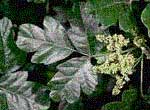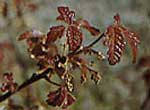Poison Oak
This is a major problem in some Bay Area parks (http://baoc.org/maps/locales.php). If you don't know what poison oak looks like, the photos at the left show its spring and summer appearance, and how it turns red in the fall.
If you see any PO, go around it, not through it. Remember the motto: bright red leaves of three, let it be.
The standard PO precautions as as follows: Avoid touching the plant if at all possible. Wear long sleeves and long pants. As soon as possible after the event, preferably at the event site, remove all exterior clothes and shoes and put them in a plastic bag, and do not touch them again until they are washed. Use Tecnu at the event site, trying to rub it in on as much exposed skin as possible. Some people rinse it off, but I usually just take a towel and wipe off the excess oil after a few minutes, and then toss the towel in the contaminated bag. Put clean clothes on. When you get home, toss those clothes in the contaminated bag, reapply Tecnu before you shower. (You should do your tick search at that time.) Let the Tecnu work for a few minutes, and then thoroughly rinse it off in the shower, preferably with lukewarm water, not hot water (which opens your pores and lets in the PO oil).
If you are very allergic or were in some serious PO, you will probably still get some rash in the next 24 to 72 hours. As soon as you notice some small red bumps or itching, apply a prescription strength steroid cream to the affected area. Some people use Fluocinonide 0.05% cream. It is generic and relatively inexpensive, but you do need a doctor's prescription. Repeat application of the steroid cream every 3 to 4 hours as needed to beat down the rash.
If you follow these guidelines, most people are fairly comfortable. However, do not let it become a huge, red, weeping rash, for which you will have to see a physician and go on systemic steroids.
Be forewarned, poison oak is a chameleon—it can manifest itself as ankle-high plants, huge shrubberies, or vines winding around trees.
There are several products that claim to provide protection either before or after exposure (note, however, that their mention here does not constitute any endorsement):
- BAOC orienteers swear by Tecnu (http://www.1800itching.com/products.cfm?id=1F5604C8-9D05-4675-56129F6D83DF2417§ion=1) for prevention and treatment of the itchy rash that comes with exposure. It is used to wash after exposure. (Some people claim that ordinary dish soap works just as well.)
- büji Block (http://www.bujiproducts.com/buji-block.html) is a pre-contact prevention and büji Wash (http://www.bujiproducts.com/buji-wash.html) is an after-contact wash.
- Cortaid (http://cortaid.com/prod_ivy_care.jsp) is a 2-step "treatment kit" for use after exposure.
- IvyBlock (http://www.ivyblock.com/ivyblock.php) is a pre-contact prevention and IvyCleanse (http://www.ivyblock.com/ivycleanse.php) towelettes are for use after exposure.
- Zanfel (http://www.zanfel.com/) is claimed (http://poisonivy.aesir.com/view/zanfel.html) to be a very effective cure and treatment for poison-oak rash (but it's rather expensive!).
For more information on this bane of orienteers, see the Poison Oak FAQ (http://www.knoledge.org/oak/), the Poison Ivy, Oak, and Sumac Information Center (http://poisonivy.aesir.com/), or the Tecnu Poison Ivy and Oak Guide (http://www.teclabsinc.com/tips-advice/facts-fiction/poison-ivy-and-oak-guide).


